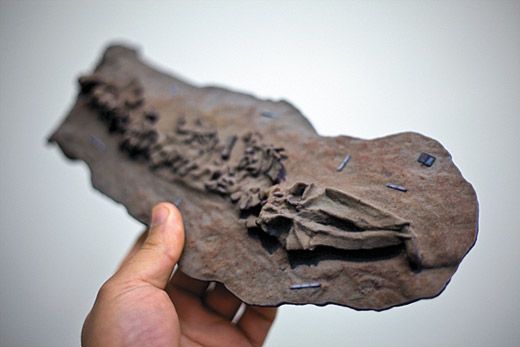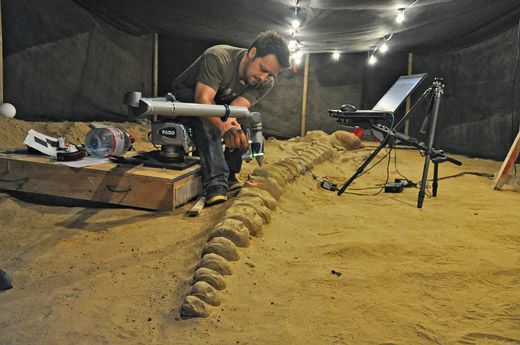How Two Laser Cowboys Saved The Day
Paleontologist Nick Pyenson was in a race against a construction crew to salvage a bed of whale fossils, so he called upon 3-D technologists for help
/https://tf-cmsv2-smithsonianmag-media.s3.amazonaws.com/filer/ATM-Save-Whalebones-Vince-Rossi-631.jpg)
It was October 5, 2011, one of the final days of Nick Pyenson’s Chilean dig, and the whale paleontologist had every reason to feel pleased. The weather had been excellent and the setting exceptional, the Atacama Desert aflame with pink flowers. His team had collected the feet of an ancient species of penguin, the ankles of an extinct seal and some fossilized dolphinear bones from above a seven-million-year-old rock bed. He decided to spend some of his last precious hours at a site nearby, where construction workers widening the Pan-American Highway were excavating the remains of a dozen whales.
“We drove up the ramp from the south and I was blown away,” recalls Pyenson, the curator of fossil marine mammals at the National Museum of Natural History. “Whale skull. Whale skull. Whale skull.” But before he could wrap his mind around these discoveries, he spied an even more extraordinary fossil formation—two adult baleen whales lying side by side, a juvenile cradled between them. Highway workers had taken to calling the group “La Familia.”
Pyenson immediately knew he wanted to return to Whale Hill, as it was soon nicknamed, to piece together what had happened to La Familia and the dozens of other whales that died within a few hundred yards of them. Though 18-wheelers hurtled within inches of their tails, many of the fossils were still in beautiful condition. But Pyenson’s Chilean colleagues warned that the whole site would be paved over within two months, and local museum workers were already jacketing the bones in plaster and warehousing them. Once the fossils were removed from the ground, their context would be lost.
“Animals die and are deposited in an environment of one kind or another,” Pyenson explains. “Knowing how they came to rest, the sediment they are buried in, whether they were scavenged, whether sharks bit them and what other bones are found nearby” are among the most telling details for paleontologists. As he flew home to Washington, he feared that information was as good as gone.
Three weeks later, he was back on a plane to Chile. By his side were Vince Rossi and Adam Metallo, members of the Smithsonian’s new 3-D digitization team, which makes minutely detailed laser scans of artifacts. If the two “laser cowboys,” as Pyenson calls them, could create virtual models of the Whale Hill specimens in their original positions, scientists could study the site forever.
Rossi and Metallo began painstakingly tracing the whales with lasers (among other recording technologies). “Day and night, we passed the scanner back and forth,” Rossi says; their arms, knees and backs ached. “It was worth it,” Metallo says. The digital avatars turned out better than they could have hoped. One of the more complete whales was about 26 feet long, but they mapped it at a level of detail normally reserved for baseball-size objects.
Today, all the whales have been removed and their resting places obliterated. But, using rock samples together with the scans, Pyenson can still explore how the animals died. Perhaps it was a stranding, or shark attacks, or a tsunami. He’s particularly interested in the orangish algae residue visible on some fossils and in images of the ancient seafloor. Toxic algae blooms commonly kill modern whales.
Eventually the site’s delicate bone remnants will be scanned as well. One particularly important whale cranium is as fragile in places as glass—difficult to store. But soon scientists may be able to e-mail images of the skull to one another anywhere in the world.

